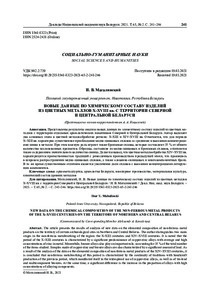Please use this identifier to cite or link to this item:
https://elib.psu.by/handle/123456789/28504| Title: | Новые данные по химическому составу изделий из цветных металлов Х–ХVIII вв. с территории Северной и Центральной Беларуси |
| Authors: | Магалинский, И. В. Mahalinski, I. |
| Other Titles: | NEW DATA ON THE CHEMICAL COMPOSITION OF THE NON-FERROUS METAL PRODUCTS OF THE X–XVIII CENTURIES ON THE TERRITORY OF NORTHERN AND CENTRAL BELARUS |
| Issue Date: | 2021 |
| Publisher: | НАНБ |
| Citation: | Mahalinski, I. (2021) NEW DATA ON THE CHEMICAL COMPOSITION OF THE NON-FERROUS METAL PRODUCTS OF THE X-XVIII CENTURIES ON THE TERRITORY OF NORTHERN AND CENTRAL BELARUS. DOKLADY NATSIONALNOI AKADEMII NAUK BELARUSI Volume 65 Issue 2 Page 241-246.doi: 10.29235/1561-8323-2021-65-2-241-246 |
| Abstract: | Представлены результаты анализа новых данных по элементному составу изделий из цветных металлов с территории отдельных археологических памятников Северной и Центральной Беларуси. Автор выделяет два основных этапа в цветной металлообработке региона: X–XIII и XIV–XVIII вв. Отмечается, что для периода X–XIII вв. характерно существенное преобладание медно-цинковых сплавов со средними и высокими концентрациями цинка в металле. При этом важную роль играют также бронзовые сплавы, которые составляют 35 % от общего количества исследованных предметов. Образцы, состоящие из медно-цинковых и бронзовых сплавов, отличаются также содержанием значительного количества свинца. Делается вывод, что цветная металлообработка XIV–XVIII вв. характеризуется преемственностью традиций с ремесленным производством предыдущей эпохи, что проявилось в широком распространении медно-цинковых сплавов, а также оловянно-свинцовых и многокомпонентных бронз. В то же время существенным отличием является увеличение доли сплавов с высокими концентрациями легирующих компонентов.= The article presents the results of analysis of new data on the elemental composition of non-ferrous metal products on the territory of certain archaeological sites in Northern and Central Belarus. The author distinguishes two main stages in the non-ferrous metalworking of the region: the X–XIII centuries and XIV–XVIII centuries. It is noted that the period of the X–XIII centuries is characterized by a significant predominance of copper-zinc alloys with average and high concentrations of zinc in metal. Meanwhile, bronze alloys also play an important role, accounting for 35 % of the total number of the items studied. Samples made of copper-zinc and bronze alloys are also characterized by a significant amount of lead. As a result of the analysis of the data on the elemental composition of non-ferrous metal products of the XIV–XVIII centuries, it is concluded that non-ferrous metalworking of this period is characterized by the continuity of traditions with handicraft production of the previous period, which manifested itself in the widespread use of copper-zinc alloys, as well as of tin-lead and multicomponent bronzes. At the same time, a significant difference is the increase in the proportion of alloys with high concentrations of alloying components. |
| Keywords: | Археометаллургия Археология Беларуси Ювелирное производство Материальная культура Химический состав древних металлов Archaeometallurgy Archeology of Belarus Jewelry production Material culture Chemical composition of ancient metals |
| URI: | https://elib.psu.by/handle/123456789/28504 |
| metadata.dc.identifier.doi: | 10.29235/1561-8323-2021-65-2-241-246 |
| Appears in Collections: | Публикации в Scopus и Web of Science |
Files in This Item:
| File | Description | Size | Format | |
|---|---|---|---|---|
| Mahalinski_2021.pdf | 632.76 kB | Adobe PDF |  View/Open |
Items in DSpace are protected by copyright, with all rights reserved, unless otherwise indicated.